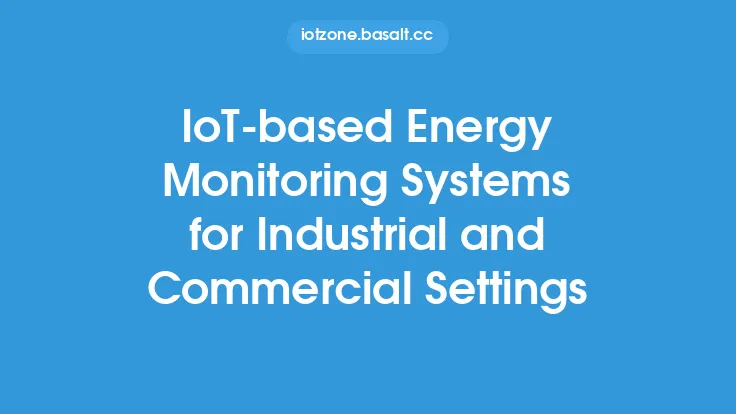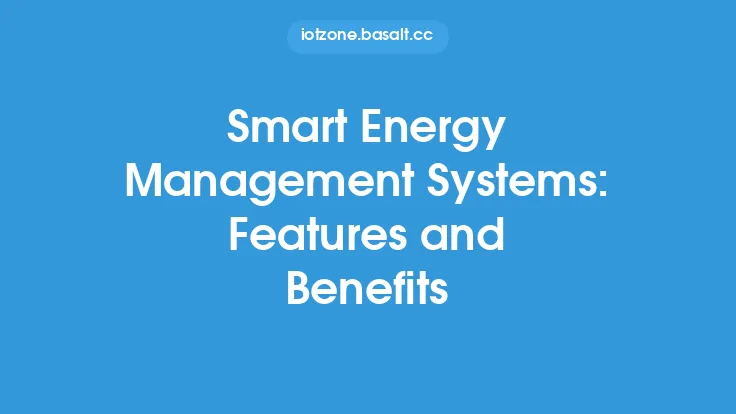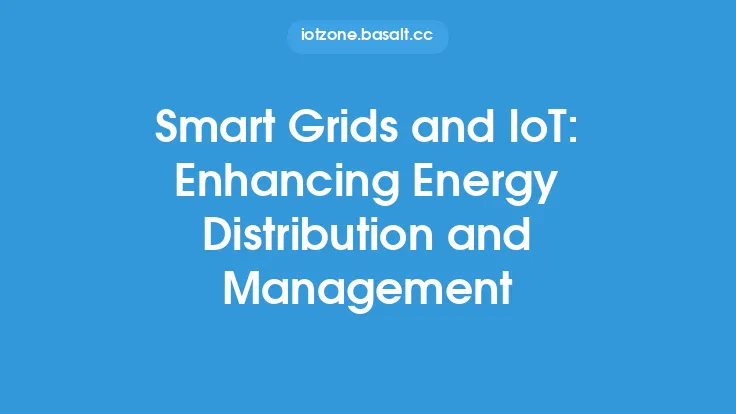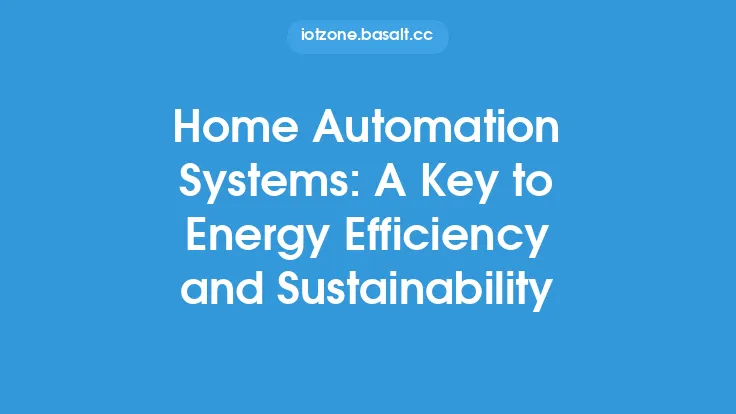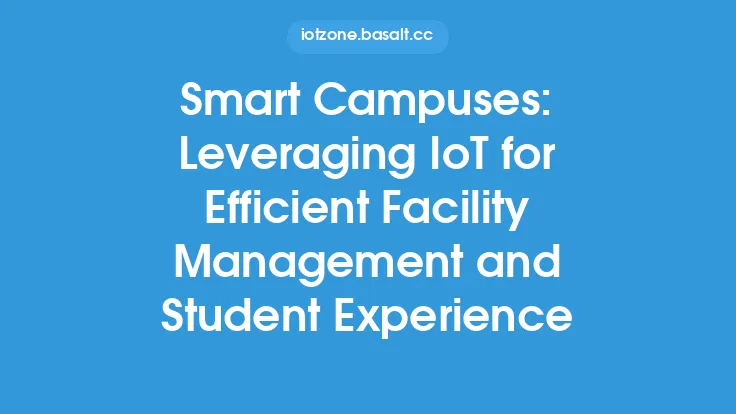The increasing demand for energy, coupled with the need to reduce carbon footprint and costs, has led to a significant interest in the implementation of IoT-based energy management systems. These systems utilize a network of sensors, actuators, and other devices to collect and analyze data on energy consumption, allowing for real-time monitoring and optimization of energy usage. By leveraging IoT technologies, organizations can reduce their energy costs, minimize their environmental impact, and improve their overall energy efficiency.
Introduction to IoT-based Energy Management Systems
IoT-based energy management systems are designed to provide a comprehensive and integrated approach to energy management. These systems typically consist of a combination of hardware and software components, including sensors, gateways, and cloud-based platforms. The sensors are used to collect data on energy consumption, such as temperature, humidity, and power usage, while the gateways provide a secure and reliable connection to the cloud-based platform. The cloud-based platform is used to analyze the data, identify trends and patterns, and provide insights and recommendations for optimizing energy usage.
Key Components of IoT-based Energy Management Systems
The key components of IoT-based energy management systems include:
- Sensors and Devices: These are used to collect data on energy consumption, such as temperature, humidity, and power usage. Examples of sensors and devices include smart meters, thermostats, and occupancy sensors.
- Gateways and Networking: These provide a secure and reliable connection to the cloud-based platform, allowing for the transmission of data and control signals. Examples of gateways and networking technologies include Wi-Fi, Ethernet, and cellular networks.
- Cloud-based Platforms: These are used to analyze the data, identify trends and patterns, and provide insights and recommendations for optimizing energy usage. Examples of cloud-based platforms include energy management software, data analytics platforms, and IoT platforms.
- Data Analytics and Machine Learning: These are used to analyze the data and provide insights and recommendations for optimizing energy usage. Examples of data analytics and machine learning techniques include predictive analytics, regression analysis, and neural networks.
Benefits of IoT-based Energy Management Systems
The benefits of IoT-based energy management systems include:
- Reduced Energy Costs: By optimizing energy usage and reducing waste, organizations can reduce their energy costs and improve their bottom line.
- Minimized Carbon Footprint: By reducing energy consumption and optimizing energy usage, organizations can minimize their carbon footprint and contribute to a more sustainable future.
- Improved Energy Efficiency: By providing real-time monitoring and optimization of energy usage, IoT-based energy management systems can help organizations improve their energy efficiency and reduce their energy waste.
- Enhanced Operational Efficiency: By providing insights and recommendations for optimizing energy usage, IoT-based energy management systems can help organizations enhance their operational efficiency and improve their overall performance.
Technical Requirements for Implementing IoT-based Energy Management Systems
The technical requirements for implementing IoT-based energy management systems include:
- Scalability and Flexibility: The system should be able to scale to meet the needs of the organization and be flexible enough to accommodate changing energy usage patterns.
- Security and Reliability: The system should be secure and reliable, with robust encryption and authentication mechanisms to protect against cyber threats.
- Data Analytics and Machine Learning: The system should be able to analyze the data and provide insights and recommendations for optimizing energy usage, using techniques such as predictive analytics and machine learning.
- Integration with Existing Systems: The system should be able to integrate with existing energy management systems, such as building management systems (BMS) and supervisory control and data acquisition (SCADA) systems.
Best Practices for Implementing IoT-based Energy Management Systems
The best practices for implementing IoT-based energy management systems include:
- Conducting a Thorough Energy Audit: Before implementing an IoT-based energy management system, organizations should conduct a thorough energy audit to identify areas of energy waste and opportunities for optimization.
- Selecting the Right Technology: Organizations should select the right technology for their IoT-based energy management system, taking into account factors such as scalability, security, and integration with existing systems.
- Providing Training and Support: Organizations should provide training and support to employees and stakeholders, to ensure that they are able to use the system effectively and optimize energy usage.
- Continuously Monitoring and Evaluating: Organizations should continuously monitor and evaluate the performance of their IoT-based energy management system, making adjustments and improvements as needed to optimize energy usage and reduce costs.
Case Studies and Examples
There are many case studies and examples of organizations that have successfully implemented IoT-based energy management systems, including:
- Commercial Buildings: Many commercial buildings have implemented IoT-based energy management systems, using sensors and data analytics to optimize energy usage and reduce costs.
- Industrial Facilities: Industrial facilities have also implemented IoT-based energy management systems, using sensors and data analytics to optimize energy usage and improve operational efficiency.
- Smart Cities: Many cities have implemented IoT-based energy management systems, using sensors and data analytics to optimize energy usage and reduce costs, and to improve the overall quality of life for citizens.
- Utilities and Energy Providers: Utilities and energy providers have also implemented IoT-based energy management systems, using sensors and data analytics to optimize energy distribution and management, and to improve customer service.
Conclusion
IoT-based energy management systems offer a powerful solution for organizations looking to reduce their energy costs, minimize their carbon footprint, and improve their overall energy efficiency. By leveraging IoT technologies, such as sensors, gateways, and cloud-based platforms, organizations can provide real-time monitoring and optimization of energy usage, and make data-driven decisions to improve their energy management. As the demand for energy continues to grow, and the need to reduce carbon footprint and costs becomes increasingly important, IoT-based energy management systems are likely to play a critical role in the future of energy management.
